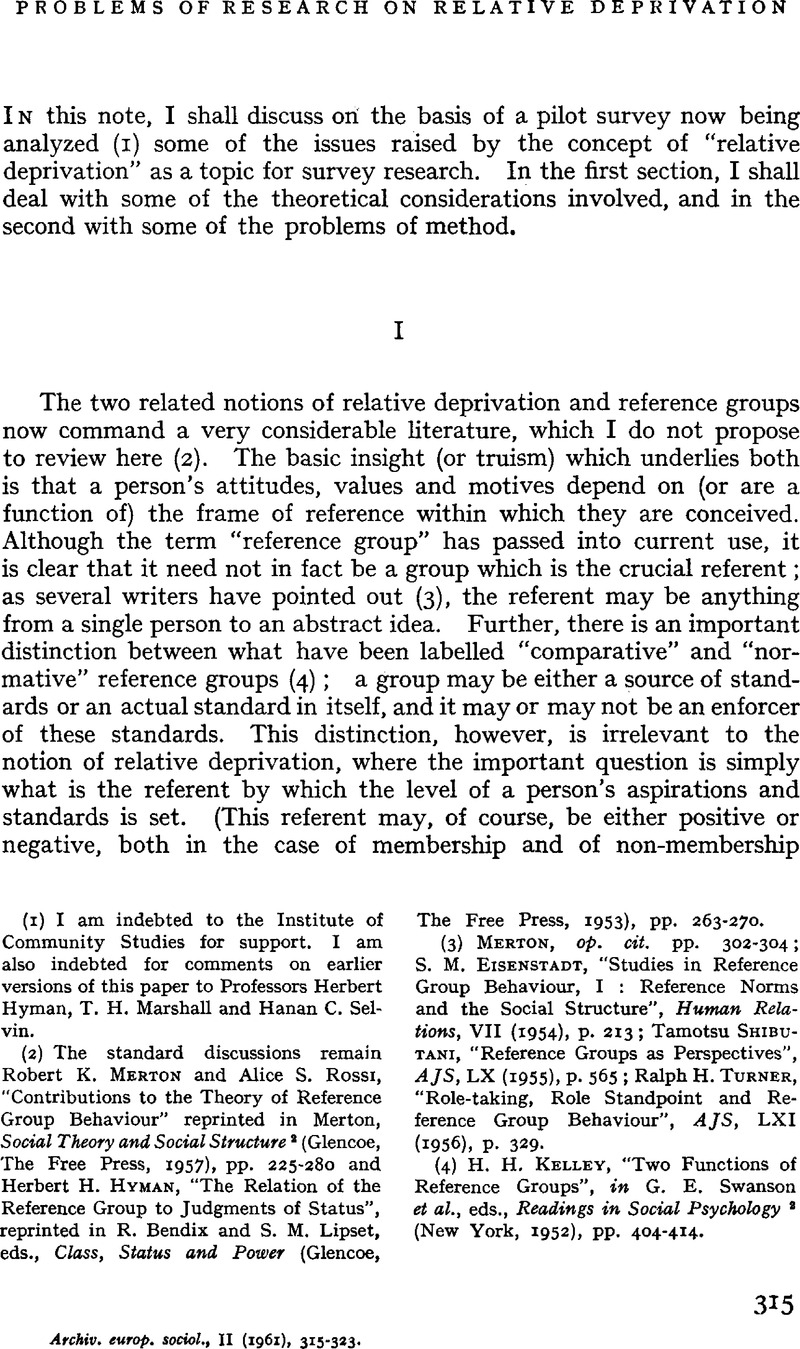Article contents
Problems of Research on Relative Deprivation
Published online by Cambridge University Press: 28 July 2009
Abstract

- Type
- Notes Critiques
- Information
- European Journal of Sociology / Archives Européennes de Sociologie , Volume 2 , Issue 2 , December 1961 , pp. 315 - 323
- Copyright
- Copyright © Archives Européenes de Sociology 1961
References
(1) I am indebted to the Institute of Community Studies for support. I am also indebted for comments on earlier versions of this paper to Professors Herbert Hyman, T. H. Marshall and Hanan C. Selvin.
(2) The standard discussions remain Merton, Robert K. and Rossi, Alice S., “Contributions to the Theory of Reference Group Behaviour”Google Scholar reprinted in Merton, , Social Theory and Social Structure (Glencoe, The Free Press, 1957), pp. 225–280Google Scholar and Hyman, Herbert H., “The Relation of the Reference Group to Judgments of Status”, reprinted in Bendix, R. and Lipset, S. M., eds., Class, Status and Power (Glencoe, The Free Press, 1953), pp. 263–270.Google Scholar
(3) Merton, , op. cit. pp. 302–304Google Scholar; Eisenstadt, S. M., “Studies in Reference Group Behaviour, I: Reference Norms and the Social Structure”, Human Relations, VII (1954), p. 213Google Scholar; Shibutani, Tamotsu, “Reference Groups as Perspectives”, AJS, LX (1955), p. 565Google Scholar; Turner, Ralph H., “Role-taking, Role Standpoint and Reference Group Behaviour”, AJS, LXI 1956), p. 329.Google Scholar
(4) Kelley, H. H., “Two Functions of Reference Groups”, in Swanson, G. E. et al. , eds., Readings in Social Psychology (New York, 1952), pp. 404–414.Google Scholar
(5) Merton, , op. cit. pp. 300–302Google Scholar; Martin, F. M., “Some Subjective Aspects of Social Stratification”, in Glass, D. V., ed., Social Mobility in Britain (London, 1954). Pp. 59–60.Google Scholar
(6) Willener, A., Images de la société et classes sociales (Berne, 1957).Google Scholar
(7) Popitz, H. et al. , Das Gesellschaftsbild des Arbeiters (Tübingen, 1961).Google Scholar
(8) Bott, Elizabeth, Family and Social Network (London, 1957)Google Scholar, ch. vi: “Norms and Ideology: Concepts of Class”.
(9) Dahrendorf, R., Class and Class Conflict in an Industrial Society (Stanford, 1959). P. 217.Google Scholar
(10) P. E. P., “Poverty: Ten Years After Beveridge”, Planning, No. 344 (1952), p. 36.Google Scholar
(11) Titmuss, Richard M., Essays on “The Welfare State” (London, 1958), Pp. 13–33Google Scholar; Cf. Friis, Henning, “The Application of Sociology to Social Welfare, Planning and Administration” in Transactions of the Fourth World Congress Sociology (London, 1959), II, pp. 66–67.Google Scholar
(12) E. g. Abrams, Mark and Rose, Richard, Must Labour Lose? (Penguin Books, 1960), p. 18 (table 4).Google Scholar
(13) Hollingshead, A. B. and Redlich, F., Social Class and Mental Illness (New York, 1958), p. 105CrossRefGoogle Scholar. The authors also comment that “strivers” identify in significantly larger numbers with a higher class.
(14) Hoggart, Richard, The Uses of Literacy (London, 1957), esp. ch. 111.Google Scholar
(15) Hyman, Herbert, “The Value Systems of Different Classes: a Social Psychological Approach to the Analysis of Stratification”, in Bendix, R. and Lipset, S. M., eds., Class, Status and Power (Free Press, 1953), pp. 426–442.Google Scholar
(16) Stern, Eric and Keller, Suzanne, “Spontaneous Group References in France”, Public Opinion Quarterly, XVII (1953), pp. 208–217.CrossRefGoogle Scholar
(17) This difficulty appears to have been encountered in a recent American attempt to relate reference group theory to voting behaviour. See Kaplan, Norman, Reference Group Theory and Voting Behaviour (unpubd. Ph. D. Thesis, Columbia University, 1955)Google Scholar, abstracted in Dissertation Abstracts, XV (1955), p. 1458.Google Scholar
(18) See n. 2, above.
(19) Chapman, Dwight W. and Volkmann, John, “A Social Determinant of the Level of Aspiration”, reprinted in Maccoby, E. E. et al. , eds., Readings in Social Psychoogy (New York, 1958), pp. 281–290.Google Scholar
- 25
- Cited by




